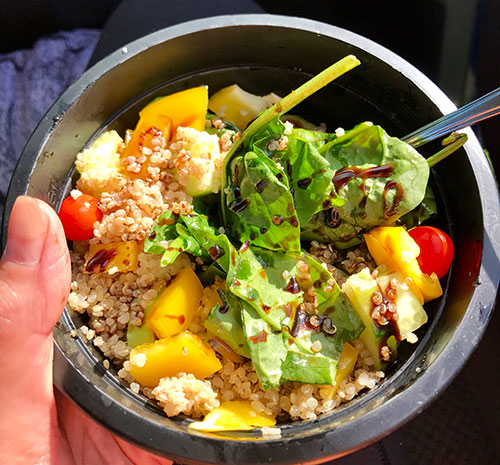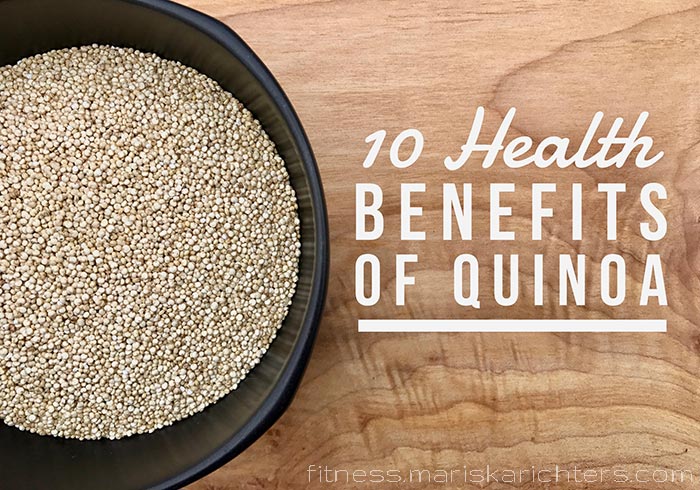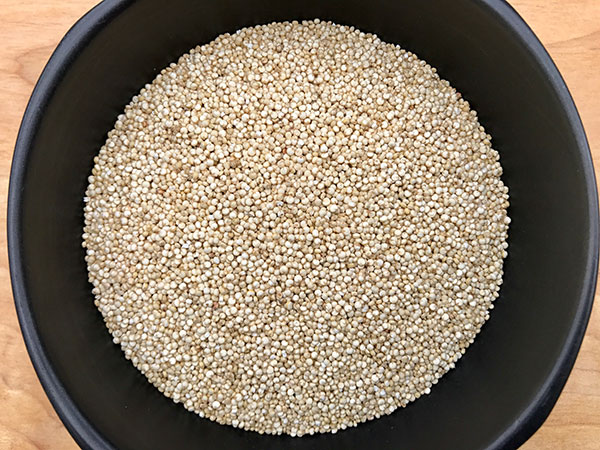Quinoa is fast becoming a staple in our house. I’ve found that rice just doesn’t sit well with me anymore and as much as I loooove rice, I just feel better when I don’t eat it. So I’ve pretty much substituted quinoa where I would normally have rice. I eat quinoa with curries and sauces, or I add it to a salad, or sometimes I even bake with it! It’s such a versatile grain, I love it!
Quinoa dates back to sometime between 3000 and 5000BC and originated in the area surrounding Lake Titicaca in Peru and Bolivia. It was called the “mother grain” by the Incas and was a staple food in their daily diets.
Although there are many varieties of quinoa, white quinoa is the most common on that you’ll find in stores. I buy mine in bulk at Costco, since we eat so much of it.
10 Health Benefits of Quinoa
- Quinoa is a complete protein. It contains 8 grams of quality protein, which makes it an excellent plant-based protein source for vegetarians and vegans.
- Quinoa is gluten free, non-GMO and usually grown organically. I have found that over the past 10 years I have become more sensitive to gluten, making quinoa a great option for me and anyone who suffers from celiac disease or gluten intolerance.
- Quinoa contains all 9 essential amino acids. These are amino acids that we must acquire from an external source and our bodies are not able to produce on their own.
- Quinoa is high in fiber containing 17–27 grams of fiber per 1 cup of quinoa.
- It’s high in magnesium, B-vitamins, potassium, calcium, iron, phosphorus, vitamin E, and
- Quinoa is high in antioxidants, which are substances that neutralize free radicals and are also believed to help fight aging and many diseases. Their antioxidant activity protects the kidneys, heart, pancreas, and lungs from oxidative stress.
- Quinoa has a low glycemic index. With a glycemic index of 53, quinoa is under the 55 required to be considered a food that helps stabilize blood sugar levels.
- Quinoa is rich in iron. Iron is essential for brain function and your muscles as well as for preventing anemia.
- Quinoa is high in potassium with one cup of quinoa containing 9% of the recommended daily allowance, which is important for managing hypercalciuria and kidney stones and is likely to decrease the risk of osteoporosis.
- It is believed that quinoa may help decrease the risk of inflammation. It helps promote healthy gut microbes, which are essential for preventing inflammation, obesity, and metabolic disease.
As we have learned, it just makes nutritional sense to eat more quinoa. You will feel better, have more energy, and potentially help with weight loss.
How to Cook Quinoa
Most quinoa that you buy in the stores is pre-rinsed, but if it isn’t you should rinse it before cooking. This helps rinse off the bitter tasting coating.
- Add 1 part quinoa and 2 parts water or stock and a pinch of salt to a pot.
- Bring the pot to a boil with the lid off.
- Once it boils, turn the heat down to a simmer and put the lid on the pot.
- Simmer for 15 minutes, remove from heat, remove the lid, and let stand for about 5 minutes.
- Fluff the quinoa with a fork and it’s ready to serve.
Quinoa is very easy to make ahead of time and keep in the fridge until you are ready to add it to a salad or re-heat it to add to a meal. I usually cook enough to last a few days for quinoa salads and then add my veggies, protein and dressing to it just before I eat it – this helps the veggies stay fresh.




